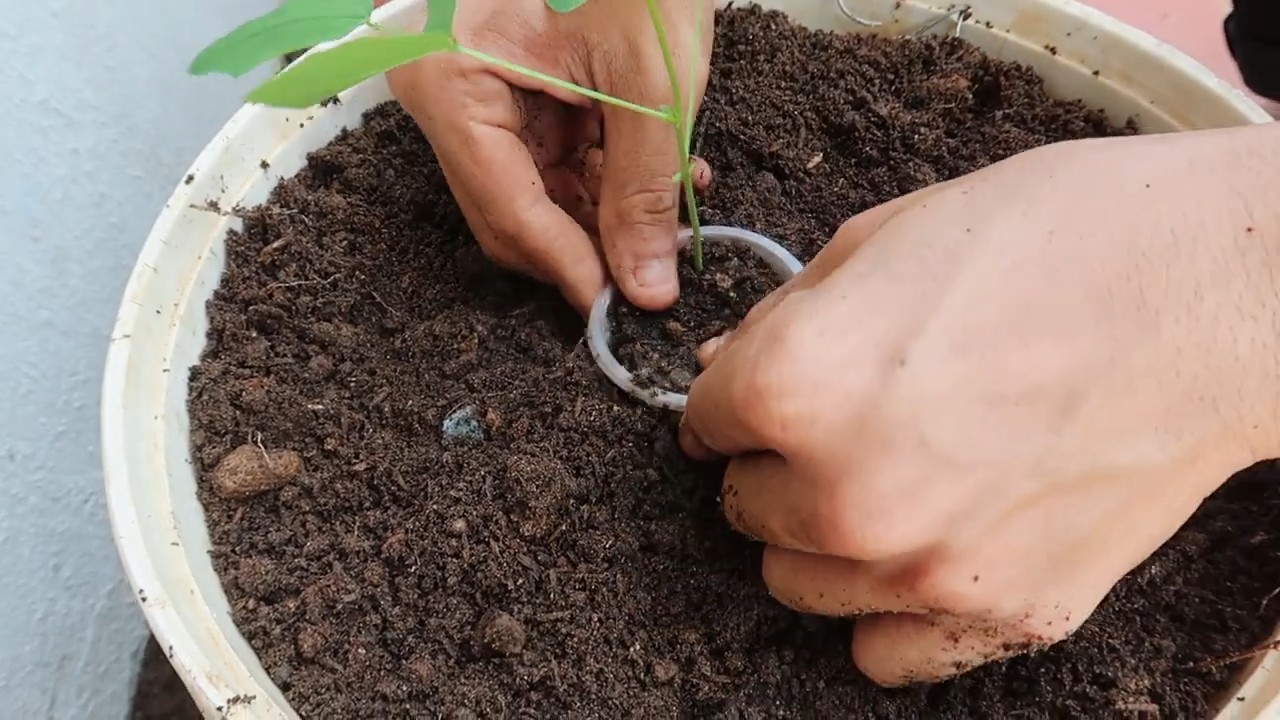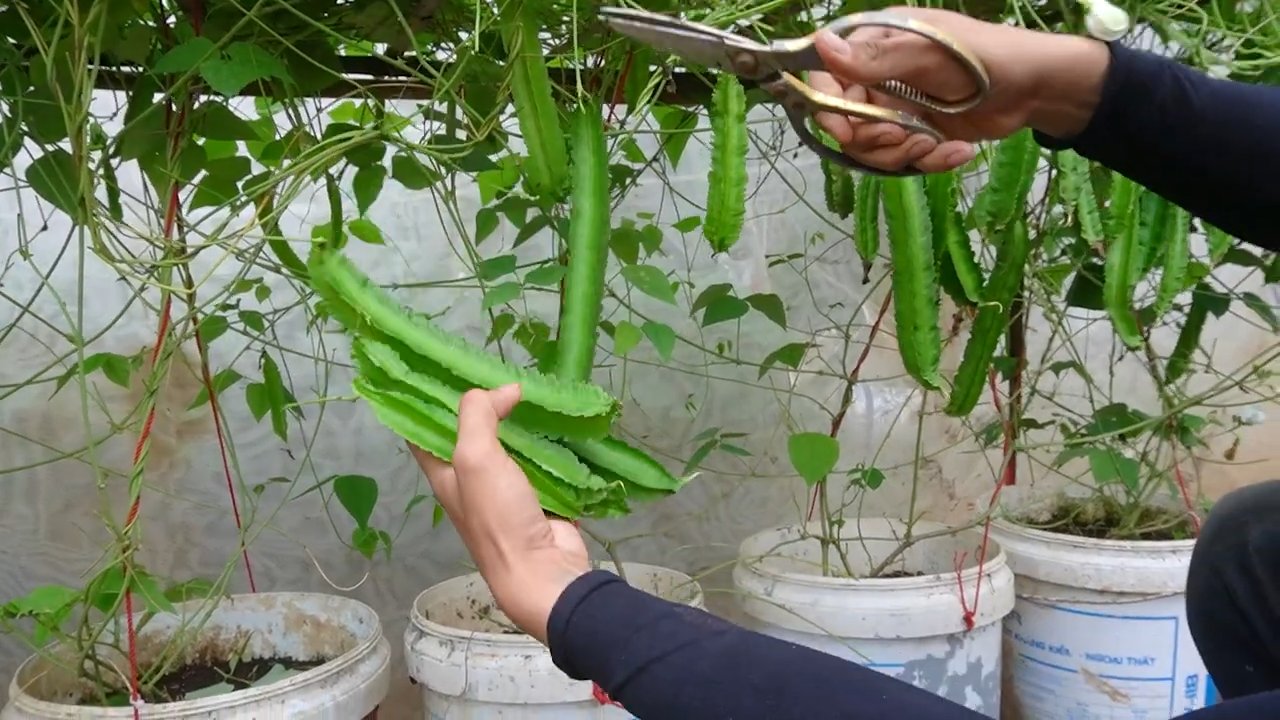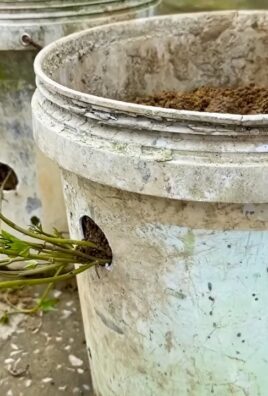Growing winged beans might sound like something out of a fantasy novel, but trust me, it’s a real and rewarding experience you can have right in your own backyard! Forget those boring green beans; we’re talking about a vibrant, versatile, and utterly delicious legume that’s been a staple in Southeast Asian cuisine for centuries. Imagine impressing your friends and family with a unique vegetable they’ve probably never even heard of, let alone tasted!
For generations, winged beans have been cherished for their nutritional value and adaptability. They’re not just a pretty face; every part of the plant, from the pods and leaves to the roots and seeds, is edible and packed with protein and vitamins. But let’s be honest, sometimes the thought of cultivating something “exotic” can feel a little daunting. That’s where this DIY guide comes in!
I’m here to show you that growing winged beans is surprisingly easy, even if you’re a complete beginner. We’ll break down the process into simple, manageable steps, sharing all the insider tips and tricks I’ve learned along the way. Whether you’re looking to add some excitement to your garden, boost your healthy eating habits, or simply impress your neighbors with your green thumb, this article is your ultimate guide to successfully cultivating this amazing plant. Let’s get started and unlock the secrets to a bountiful winged bean harvest!

Growing Winged Beans: A Comprehensive DIY Guide
Winged beans, also known as asparagus peas or goa beans, are a fantastic addition to any garden. They’re not only beautiful with their vibrant flowers and unique pod shapes, but they’re also incredibly nutritious, offering edible pods, leaves, flowers, seeds, and even tubers! I’ve been growing them for a few years now, and I’m excited to share my experience and guide you through the process. It might seem a little daunting at first, but trust me, it’s totally worth it!
Choosing the Right Variety and Location
Before we dive into the nitty-gritty, let’s talk about variety and location. These factors play a crucial role in the success of your winged bean adventure.
* Variety Selection: There are several varieties of winged beans available, each with slightly different characteristics. Some are better suited for specific climates, while others might have different pod lengths or colors. Do a little research to find a variety that thrives in your region. Local nurseries are a great resource for this!
* Sunlight: Winged beans are sun-worshippers! They need at least 6-8 hours of direct sunlight each day to flourish. Choose a spot in your garden that gets plenty of sunshine.
* Soil: Well-draining soil is essential. Winged beans don’t like soggy feet! Amend your soil with compost or other organic matter to improve drainage and fertility. A slightly acidic to neutral pH (around 6.0-7.0) is ideal.
* Support System: These are climbing plants, so they need a sturdy trellis, fence, or other support structure to climb on. Plan for this in advance!
Step-by-Step Planting Guide
Now, let’s get our hands dirty! Here’s a detailed guide to planting your winged beans:
1. Seed Preparation (Optional but Recommended): Winged bean seeds have a hard outer shell, which can sometimes hinder germination. To improve your chances of success, you can scarify the seeds. Gently rub the seeds with sandpaper or nick them with a knife. Be careful not to damage the inner part of the seed! Alternatively, you can soak the seeds in warm water for 12-24 hours before planting. This helps soften the seed coat and encourages germination.
2. Starting Seeds Indoors (Optional): If you live in a region with a short growing season, you might want to start your seeds indoors 4-6 weeks before the last expected frost. Use seed-starting trays or small pots filled with a seed-starting mix. Plant the seeds about 1 inch deep and keep the soil moist but not soggy. Place the trays in a warm, sunny location or under grow lights.
3. Direct Sowing: Once the danger of frost has passed and the soil has warmed up (ideally above 65°F or 18°C), you can direct sow the seeds into your garden. Choose a sunny spot with well-draining soil.
4. Preparing the Soil: Before planting, prepare the soil by loosening it with a garden fork or tiller. Amend the soil with compost or other organic matter to improve drainage and fertility.
5. Planting the Seeds: Sow the seeds about 1 inch deep and 2-3 inches apart. If you’re planting in rows, space the rows about 3-4 feet apart.
6. Watering: Water the seeds gently but thoroughly after planting. Keep the soil consistently moist until the seedlings emerge.
7. Providing Support: As soon as the seedlings emerge and start to grow, provide them with a trellis, fence, or other support structure to climb on. Winged beans can grow quite tall, so make sure your support is sturdy enough to handle their weight. I’ve found that a trellis made of sturdy bamboo poles works really well.
8. Thinning (If Necessary): If you planted the seeds close together, you might need to thin the seedlings once they’re a few inches tall. Thin them to about 6-12 inches apart to give them enough room to grow.
Caring for Your Winged Beans
Once your winged beans are established, it’s important to provide them with proper care to ensure a bountiful harvest.
* Watering: Water regularly, especially during dry periods. Winged beans need consistent moisture to thrive. Aim for about 1 inch of water per week.
* Fertilizing: Winged beans are legumes, which means they can fix nitrogen from the air. However, they still benefit from occasional fertilization. Use a balanced fertilizer or side-dress with compost every few weeks. Avoid over-fertilizing with nitrogen, as this can promote excessive foliage growth at the expense of pod production.
* Weeding: Keep the area around your winged beans free of weeds. Weeds compete with the plants for nutrients and water.
* Pest and Disease Control: Winged beans are generally resistant to pests and diseases. However, they can sometimes be affected by aphids, spider mites, or fungal diseases. Inspect your plants regularly and take action if you notice any problems. Insecticidal soap or neem oil can be effective for controlling aphids and spider mites. For fungal diseases, improve air circulation and avoid overhead watering.
* Pruning: Pruning isn’t strictly necessary, but it can help improve air circulation and encourage bushier growth. You can prune away any dead or damaged leaves or stems.
Harvesting Your Winged Beans
The best part! Harvesting your winged beans is a rewarding experience.
* Pod Harvest: The pods are the most commonly harvested part of the winged bean. Harvest them when they are young and tender, typically about 6-8 inches long. They should be firm and snap easily when bent. Overripe pods can become tough and fibrous. Harvest regularly to encourage continued pod production.
* Leaf Harvest: The leaves are also edible and can be harvested throughout the growing season. Choose young, tender leaves for the best flavor. They can be used in salads, stir-fries, or soups.
* Flower Harvest: The flowers are also edible and can be used as a garnish or added to salads. They have a slightly sweet flavor.
* Seed Harvest: If you want to save seeds for next year, allow some of the pods to mature and dry on the vine. Once the pods are completely dry, harvest them and extract the seeds. Store the seeds in a cool, dry place.
* Tuber Harvest: The tubers can be harvested in the fall after the plants have died back. They are similar to potatoes in texture and flavor. Dig them up carefully to avoid damaging them.
Troubleshooting Common Problems
Even with the best care, you might encounter some challenges along the way. Here are some common problems and how to address them:
* Poor Germination: If your seeds aren’t germinating, make sure the soil is warm enough and consistently moist. You can also try scarifying the seeds or soaking them in warm water before planting.
* Slow Growth: If your plants are growing slowly, make sure they’re getting enough sunlight, water, and nutrients. Amend the soil with compost or fertilizer.
* Lack of Pod Production: If your plants are growing well but not producing pods, it could be due to a lack of pollination. Winged beans are self-pollinating, but sometimes they need a little help. You can try hand-pollinating the flowers by transferring pollen from one flower to another with a small brush.
* Pest Infestations: If you notice pests on your plants, take action immediately. Insecticidal soap or neem oil can be effective for controlling aphids, spider mites, and other common pests.
* Disease Problems: If you notice signs of disease, such as yellowing leaves or spots on the foliage, improve air circulation and avoid overhead watering. You can also try using a fungicide.
Enjoying Your Harvest
Now that you’ve harvested your winged beans, it’s time to enjoy the fruits (or rather, pods!) of your labor. Winged beans are incredibly versatile and can be used in a variety of dishes.
* Raw: Young, tender pods can be eaten raw in salads or as a snack.
* Steamed: Steaming is a great way to cook winged beans while preserving their nutrients.
* Stir-fried: Winged beans are a delicious addition to stir-fries.
* Boiled: Boiling is another simple way to cook winged beans.
* Roasted: Roasting winged beans brings out their natural sweetness.
* Soups and Stews: Winged beans can be added to soups and stews for extra flavor and nutrition.
I personally love stir-frying them with garlic, ginger, and a little soy sauce. They’re also delicious in curries and stews. Don’t be afraid to experiment and find your favorite way to enjoy them!
Saving Seeds for Next Year
If you want to grow winged beans again next year, you can save seeds from your harvest. Allow some of the pods to mature and dry on the vine. Once the pods

Conclusion
So, there you have it! Growing winged beans at home is not only achievable but also incredibly rewarding. From the vibrant, nitrogen-fixing properties that enrich your soil to the delicious and versatile pods, leaves, flowers, and tubers that grace your plate, this plant truly offers a complete garden-to-table experience. Forget the expensive and often bland supermarket offerings; with a little patience and the right approach, you can cultivate your own supply of fresh, flavorful winged beans, bursting with nutrients and homegrown goodness.
This DIY trick – starting your winged beans indoors – is a game-changer, especially in regions with shorter growing seasons. It gives your plants a head start, ensuring they’re strong and ready to thrive when transplanted outdoors. Think of it as giving your winged bean seedlings a VIP pass to a successful growing season.
But don’t stop there! Experiment with different varieties of winged beans to discover your favorite flavor profiles. Some boast a sweeter taste, while others offer a more nutty or earthy note. Try trellising your plants in creative ways – a teepee structure, a repurposed fence, or even a sturdy archway can add visual appeal to your garden while providing the necessary support for these vigorous climbers.
Consider companion planting to further enhance your winged bean garden. Planting them alongside corn or sunflowers can provide natural support, while herbs like basil and rosemary can help deter pests. The possibilities are endless!
We wholeheartedly encourage you to embark on this winged bean growing adventure. It’s a fantastic way to connect with nature, learn about sustainable gardening practices, and enjoy the fruits (or rather, the beans!) of your labor. Don’t be afraid to get your hands dirty, embrace the challenges, and celebrate the successes.
And most importantly, we want to hear about your experience! Share your photos, tips, and stories with us in the comments below. What varieties did you try? What challenges did you face, and how did you overcome them? What are your favorite ways to prepare and enjoy your homegrown winged beans? Your insights can inspire and empower other gardeners to take the plunge and discover the joys of growing their own food. Let’s build a community of winged bean enthusiasts and share the knowledge! This DIY trick is a must try.
Frequently Asked Questions (FAQ)
What are the ideal growing conditions for winged beans?
Winged beans thrive in warm, humid climates with plenty of sunshine. They prefer well-drained soil that is rich in organic matter. Aim for at least 6-8 hours of direct sunlight per day. The optimal temperature range for growth is between 70°F and 85°F (21°C and 29°C). While they are relatively drought-tolerant once established, regular watering is essential, especially during flowering and pod development. Avoid waterlogging, as this can lead to root rot.
How long does it take for winged beans to mature and produce pods?
Winged beans typically take between 120 and 180 days to mature and produce pods. The exact time frame can vary depending on the variety, climate, and growing conditions. Starting your seeds indoors, as described in this article, can significantly shorten the time to harvest. You can usually begin harvesting pods about 2-3 weeks after flowering.
What are some common pests and diseases that affect winged beans, and how can I prevent or control them?
Winged beans are generally resistant to many pests and diseases, but they can occasionally be affected by aphids, spider mites, and bean beetles. Regularly inspect your plants for signs of infestation and take action promptly. You can often control these pests with organic methods, such as spraying with insecticidal soap or neem oil. Good air circulation and proper watering practices can help prevent fungal diseases. Crop rotation and choosing disease-resistant varieties can also minimize the risk of problems.
Can I grow winged beans in containers?
Yes, you can successfully grow winged beans in containers, but you’ll need to choose a large container (at least 15-20 gallons) to accommodate their extensive root system. Ensure the container has good drainage holes. Use a high-quality potting mix that is rich in organic matter. Provide a sturdy trellis or support structure for the vines to climb. Water regularly and fertilize every few weeks with a balanced fertilizer. Container-grown winged beans may require more frequent watering and fertilization than those grown in the ground.
Are all parts of the winged bean plant edible?
Yes, all parts of the winged bean plant are edible, including the pods, leaves, flowers, and tubers. The young pods are the most commonly consumed part and can be eaten raw, steamed, stir-fried, or added to soups and stews. The leaves can be used like spinach in salads or cooked dishes. The flowers can be added to salads or used as a garnish. The tubers, which are rich in protein, can be boiled, roasted, or fried.
How do I harvest winged beans?
Harvest winged beans when the pods are young and tender, typically when they are about 6-8 inches long. Use scissors or pruning shears to cut the pods from the vine, being careful not to damage the plant. Regular harvesting encourages continued pod production. The tubers can be harvested after the plant has finished flowering and the leaves begin to turn yellow. Dig them up carefully, avoiding damage to the tubers.
How do I store winged beans?
Freshly harvested winged bean pods can be stored in the refrigerator for up to a week. Place them in a plastic bag or container to prevent them from drying out. You can also freeze winged bean pods for longer storage. Blanch them in boiling water for 2-3 minutes, then transfer them to an ice bath to stop the cooking process. Drain well and freeze in airtight containers or freezer bags. The tubers can be stored in a cool, dry place for several months.
Can I save seeds from my winged bean plants?
Yes, you can save seeds from your winged bean plants for future planting. Allow some of the pods to mature and dry completely on the vine. Once the pods are dry and brittle, carefully remove the seeds. Store the seeds in an airtight container in a cool, dry place. Be aware that seeds saved from hybrid varieties may not produce plants that are true to type.
What are the nutritional benefits of winged beans?
Winged beans are a nutritional powerhouse, packed with protein, fiber, vitamins, and minerals. They are an excellent source of protein, making them a valuable food source for vegetarians and vegans. They are also rich in fiber, which promotes digestive health. Winged beans contain vitamins A, C, and B vitamins, as well as minerals like iron, calcium, and potassium. They are also a good source of antioxidants, which help protect the body against cell damage.
Where can I find winged bean seeds or plants?
Winged bean seeds can be found online from various seed suppliers specializing in heirloom or unusual varieties. Local nurseries or garden centers may also carry winged bean seeds or plants, especially in regions where they are commonly grown. Check with your local agricultural extension office for information on where to find winged bean seeds or plants in your area.




Leave a Comment